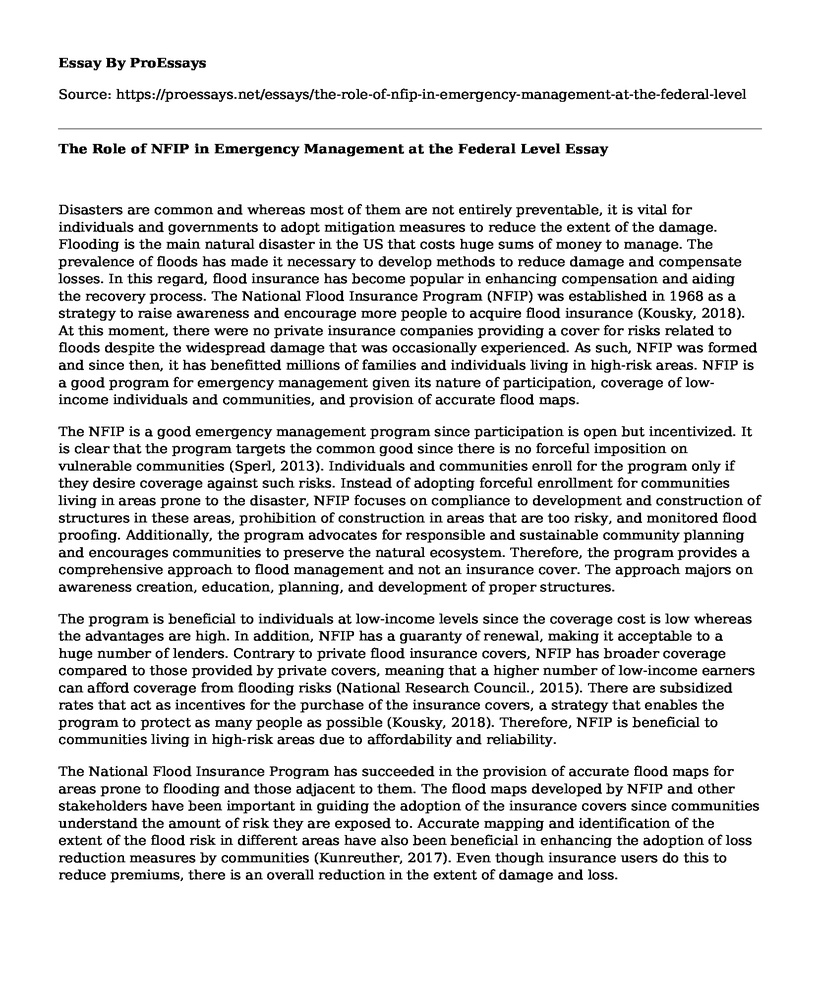Disasters are common and whereas most of them are not entirely preventable, it is vital for individuals and governments to adopt mitigation measures to reduce the extent of the damage. Flooding is the main natural disaster in the US that costs huge sums of money to manage. The prevalence of floods has made it necessary to develop methods to reduce damage and compensate losses. In this regard, flood insurance has become popular in enhancing compensation and aiding the recovery process. The National Flood Insurance Program (NFIP) was established in 1968 as a strategy to raise awareness and encourage more people to acquire flood insurance (Kousky, 2018). At this moment, there were no private insurance companies providing a cover for risks related to floods despite the widespread damage that was occasionally experienced. As such, NFIP was formed and since then, it has benefitted millions of families and individuals living in high-risk areas. NFIP is a good program for emergency management given its nature of participation, coverage of low-income individuals and communities, and provision of accurate flood maps.
The NFIP is a good emergency management program since participation is open but incentivized. It is clear that the program targets the common good since there is no forceful imposition on vulnerable communities (Sperl, 2013). Individuals and communities enroll for the program only if they desire coverage against such risks. Instead of adopting forceful enrollment for communities living in areas prone to the disaster, NFIP focuses on compliance to development and construction of structures in these areas, prohibition of construction in areas that are too risky, and monitored flood proofing. Additionally, the program advocates for responsible and sustainable community planning and encourages communities to preserve the natural ecosystem. Therefore, the program provides a comprehensive approach to flood management and not an insurance cover. The approach majors on awareness creation, education, planning, and development of proper structures.
The program is beneficial to individuals at low-income levels since the coverage cost is low whereas the advantages are high. In addition, NFIP has a guaranty of renewal, making it acceptable to a huge number of lenders. Contrary to private flood insurance covers, NFIP has broader coverage compared to those provided by private covers, meaning that a higher number of low-income earners can afford coverage from flooding risks (National Research Council., 2015). There are subsidized rates that act as incentives for the purchase of the insurance covers, a strategy that enables the program to protect as many people as possible (Kousky, 2018). Therefore, NFIP is beneficial to communities living in high-risk areas due to affordability and reliability.
The National Flood Insurance Program has succeeded in the provision of accurate flood maps for areas prone to flooding and those adjacent to them. The flood maps developed by NFIP and other stakeholders have been important in guiding the adoption of the insurance covers since communities understand the amount of risk they are exposed to. Accurate mapping and identification of the extent of the flood risk in different areas have also been beneficial in enhancing the adoption of loss reduction measures by communities (Kunreuther, 2017). Even though insurance users do this to reduce premiums, there is an overall reduction in the extent of damage and loss.Conclusion
To conclude, NFIP has had a positive impact on the compensation of disaster victims and the creation of awareness among vulnerable communities. The program is beneficial to low-income individuals and thus reduces the pressure of obtaining private flood insurance. Lastly, the program provides open participation and strengthens related policies such as those dealing in mapping.
References
Kousky, C. (2018). Financing flood losses: A discussion of the National Flood Insurance Program. Risk Management and Insurance Review, 21(1), 11-32.
Kunreuther, H. (2017). Encouraging Adaptation to Flood Risk: The Role of the National Flood Insurance Program.
National Research Council. (2015). Affordability of national flood insurance program premiums: Report 1. National Academies Press.
Sperl, B. (2013). The National Flood Insurance Program: Successes and Challenges of Federal Flood Mitigation Policy. PublicINReview, 1(3), 79-87.
Cite this page
The Role of NFIP in Emergency Management at the Federal Level. (2022, Mar 28). Retrieved from https://proessays.net/essays/the-role-of-nfip-in-emergency-management-at-the-federal-level
If you are the original author of this essay and no longer wish to have it published on the ProEssays website, please click below to request its removal:
- Scientific Opinion on Water Intake
- Antibiotics: Definition, Types, and Brief History
- Rising Cost of Pharmaceuticals Research Example
- Food Security in Haiti Paper Example
- Analytical Essay - "Sonny Blues" by James Baldwin
- Essay Example on Nurse Educator Role: An Exciting Transition to Inspire and Nurture
- Free Report Example on US Labor Market Begins Recovery: 4.8M Jobs Added in June







